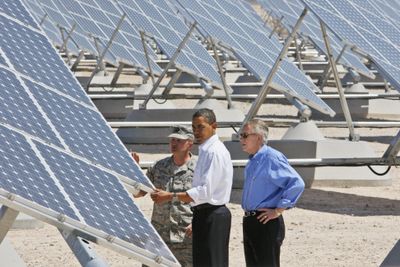Obama touts stimulus as success
Only $19 billion of $787 billion package has been spent; jobs outlook remains grim

WASHINGTON – “Only a small part” of the nation’s $787 billion economic stimulus had been spent through the end of last month, according to congressional analysts, despite the Obama administration’s boasts Wednesday that the plan is a big success.
“One hundred days later, we are already seeing results,” President Barack Obama said during a visit to Nellis Air Force Base in Nevada.
“Across America, recovery is under way,” Vice President Joe Biden said in a statement accompanying a 28-page progress report.
However, Douglas Elmendorf, the director of the nonpartisan Congressional Budget Office, was more cautious in his “State of the Economy” review to the House Budget Committee last week.
“The economy will stop contracting and resume growing during the second half of this year,” he said, “but the hardships caused by the recession will persist for some time.”
The CBO report found that through April only about $19 billion in stimulus funds has been spent.
In addition, Elmendorf predicted, unemployment is expected to peak at 10.5 percent in the second half of next year. Last month’s rate was 8.9 percent, up from 8.1 percent in February, when the stimulus became law. The number of unemployed increased by 1.26 million during the past two months, to 13.7 million.
The administration’s report Wednesday was nonetheless upbeat, maintaining that in the past 100 days, “We have obligated more than $112 billion, created more than 150,000 jobs and helped communities and tribes in every state and territory.”
Without the stimulus, said Jared Bernstein, Biden’s chief economic adviser, those jobs wouldn’t have been available.
Moreover, Biden said, recovery is “more than just a compilation of statistics; it’s the return of hope and optimism about the future that comes with making life better for communities and families across the country.”
The CBO report said the $19 billion in stimulus funds spent was part of a $380 billion stimulus package authorized for this fiscal year, which ends on Sept. 30.
Independent economic analysts largely expected the initially slow pace of spending, as much of the money so far has gone for tax breaks, health care and other immediate needs.
The biggest chunk of stimulus spending involves infrastructure, energy, education and other projects that take time to develop, and are described in the administration report.
At Nellis, Obama announced more spending for renewable energy after touring a large field of solar panels, which he called “the largest solar electric plant of its kind in the entire Western Hemisphere.”
The sun-powered cells provide a quarter of the base’s power needs, he said.
“That’s the equivalent of powering about 13,200 homes during the day,” the president said, and it will save the Air Force nearly $1 million a year.
“We can remain the world’s leading importer of oil, or we can become the world’s leading exporter of clean energy,” he said.
Bernstein said there was a “tradeoff” between getting the money out quickly and getting it out correctly.
“Our focus is on trying to get as much money out the door as quickly as humanly possible, while ensuring that there isn’t waste,” White House Press Secretary Robert Gibbs said.
In fact, the CBO found that the stimulus should boost economic growth between 1.4 percent and 3.8 percent for 2009. “The peak effect of the stimulus on GDP is the end of this year,” Elmendorf said.
However, 2010 poses potential problems. In its March forecast, the CBO saw joblessness peaking around 9.5 percent early next year.
Now, Elmendorf said, the economy has weakened to the point that, “if we were writing down a new forecast today, we would go off that peak and we would raise it.
“Currently, we expect the unemployment rate might peak around 10.5 percent in the second half of next year.”
Worse, he warned, “The recovery will falter in 2010 if private sector demand for goods and services doesn’t accelerate to offset the diminishing federal stimulus.”
The administration’s report doesn’t specifically address next year.
“You know as we do that the road to full recovery will be long and not always smooth,” Biden said.